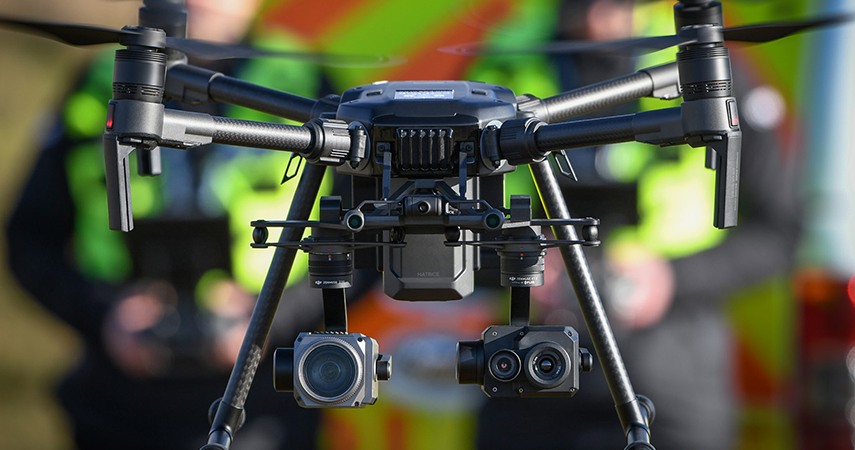Police Scotland launch smart drones to find missing people

Drone technology is moving at pace, bringing with it many opportunities. In the UK, however, regulators have been slow to react in outlining a vision for the future use of drones, often citing wider risks. Is this preventing widespread use among emergency services? And what can be done about it?
Countless instances of drones being used to disrupt airport traffic and infringe on peoples’ privacy have seemingly stifled the mainstream acceptance of unmanned aerial vehicles (UAVs) in recent years.
Recently, a drone flying in controlled airspace near Gatwick forced an airliner carrying 186 passengers to take avoiding action. This was just the latest in a series of incidents involving drones and aircraft. In 2018, 125 near-misses involving drones were reported, an increase of 34% on the previous year. In 2014, only six near-misses were recorded.
To address this, a recent report issued by the Government attempted to outline the UK’s plans for the future of drone use in the UK. The report assessed the risks, benefits and potential sticking points, based on research and advice from key industry figures.
In the report, the public perception of drones, along with the fear of weaponisation and concerns over privacy and the lack of a centralised regulatory body, are all seen as stumbling blocks in the widespread adoption of UAVs.
Jamie Allan, CEO of leading global drone consultancy Allan Panthera, agrees: “What we in the industry are really crying out for in the UK is a drone champion: a central authority established by the Government which creates not only a collaborative vision from across the whole spectrum of personal and professional drone users, along with the guiding principles and associated actions, but is also then the driving force through this enablement to maximise the potential of drone technology for the benefit of as many people as possible.
“I think those in power understandably had other priorities in recent years, but when they have had the chance to look at our industry they are focusing and reacting too much on the negatives in the news rather than building upon the overwhelming positives which are happening with drones every day.”

Using drones for good
From firefighting to medical delivery, or surveying in dangerous industries, drones have proven time and time again that they have a growing role in many areas – none more so than in the emergency services.
Recently, Police Scotland has unveiled a new drone system to assist in searches for missing people.
The remotely-piloted aircraft system (RPAS) is being used to search vast areas in Scotland. Using advanced computer vision technology and neural networks, the RPAS can locate a missing person from up to 150 metres away.
Trialled earlier this year, the drones are based in Aberdeen and Inverness. The addition of the RPAS to the force’s air support will allow them to search areas in which terrain and weather might have previously made it impossible.
The system is a collaboration between Police Scotland and Thales – a defence, aerospace and transport multinational – along with the University of the West of Scotland (UWS). The partnership, facilitated by the not-for-profit innovation centre CENSIS, aimed to bring public and private sectors together for advances in technology, including IoT and computer vision.

Police Scotland’s RPAS needs only two trained officers to operate – one to pilot the UAV and one to interpret the image data. Due to the system’s use of artificial intelligence, it learns from its previous missions to improve each and every time.
Jamie Allan, also a Special Constable with Scotland Police, said: “It’s great to see the UK’s second-largest police force take drones beyond their basic capabilities and enhance them for our specific, operational needs. It will save lives, and there is simply no price you can put on that.”
READ MORE: How can technology fight forest fires?
New technologies deployed by any police force can often raise questions of privacy, perhaps it is a fear which could be allayed with the introduction of a central governing body or continued education on drone practice and safety.
Speaking to the BBC, Inspector Nicholas Whyte of Police Scotland’s air support unit, said that the drones they use are a “very overt policing tool,” and that they’re not operating secretly.
“We’re not hiding anything. It’s there to help people, it’s there to find people.”
Insp Whyte said that the force will comply fully with all the relevant legislation, and a social media announcement will be made prior to deployment.
Aside from use in the public sector services, the growing use of drones could have a huge economic boost – something that both private and public organisations should not ignore.
The economic impact of drones
According to a report by PwC, the continued integration of drones benefits not only the public services but a range of industries, too.
From the surveying of off-shore oil rigs and other dangerous, remote places of industry to the transport and logistics sector, the increasing use of UAVs could have a huge, positive economic upshot.
By 2030, it is estimated that there will be 628,000 jobs in the drone space, with over 76,000 devices in the skies.
By increasing productivity and efficiency, the UK could see a £16bn net saving to the UK economy, while at the same time giving the UK gross domestic product (GDP) a £42bn uplift.
However, many industry leaders have warned that to feel the benefits the drone industry has to offer, a co-ordinating authority is key.
Ensuring standards across the gamut of drone use, obeying appropriate legislation and the governmental facilitation of research and innovation are all vital to ensure drones really take-off, so businesses and the UK economy can reap the rewards.
“All of this will help to prevent the UK falling further behind other countries who are really pushing the envelope, and limit the damage which we’re seeing from relatively slow progression in the UK drone sector,” Jamie Allan said.
“More positive stories and use cases of drone technology such as this will hopefully break down the negative stigma which the general public is fed through often sensationalised stories, which only serve to create barriers from industry unlocking the overwhelming benefits and positive impact that drones currently, and will continue to, have on our day to day lives.”
